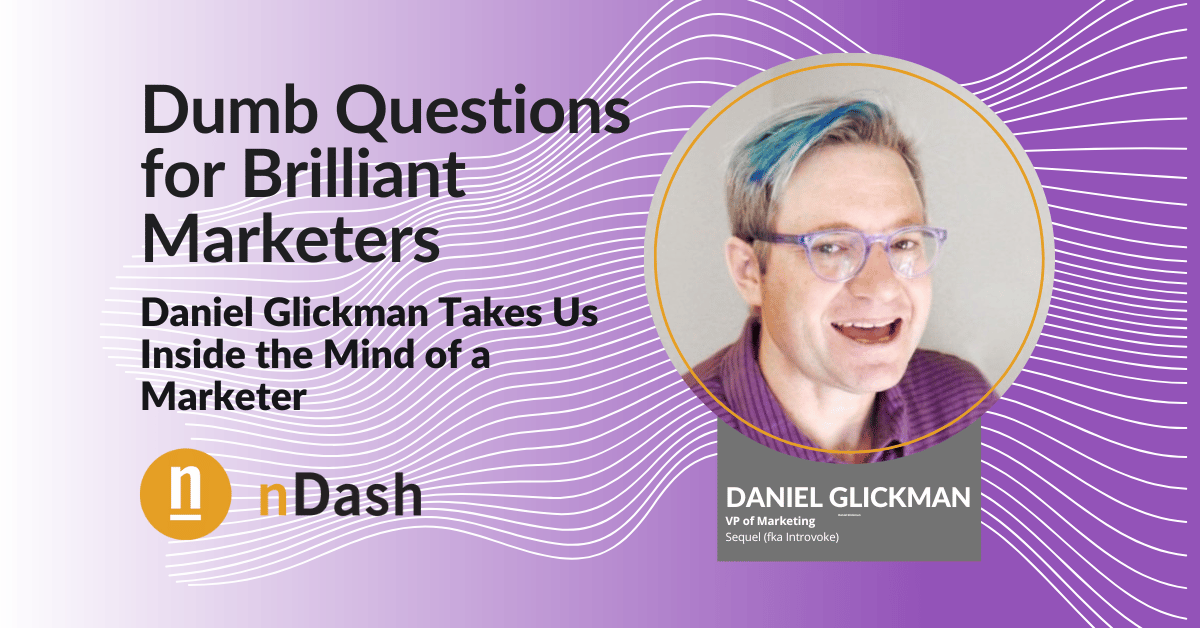Daniel Glickman Takes You Into the Mind of a Marketer
Another week, another list of dumb questions for brilliant marketers. This week’s guest is none other than Daniel Glickman. At the time of this original interview (March 12, 2017), Daniel was the Chief Marketing Officer at Roojoom. Today, he’s the VP of marketing for Sequel, the only no-code (or low-code) solution enabling brands to build live event experiences and engage with communities directly from their website.
If that name sounds familiar, it’s probably because Daniel is a prolific author, speaker, and marketing thought leader. In this Q&A, we fire off some questions related to startup marketing, the ineffectiveness of self-serving content, marketing skills gaps, alternate universes, fake Scottish accents, and more. Enjoy!
nDash: The premise of your book is that marketers need to think like startups. Is this about getting them to experiment more with new tactics and approaches? Or is it about getting them to measure results more effectively? Please give our readers a sense of what they could learn by downloading a copy.
Daniel Glickman: Well, it’s a combination of both. The idea is that startups are a lot more disruptive in nature. A startup’s biggest challenge, in terms of marketing, is that they may have a product that’s very innovative, but they need to break through the noise of the competition. They’re competing against a bigger budget, talent, experience, and all of that. So startups are very innovative and disruptive in the way they do marketing. And that’s what I talk about in the book.
I show you how to systemize that. How to get that cross-functioning team that works in an innovative, agile and creative way. The idea is, “how do you encourage creativity in a way that’s really measurable and manageable?” Not just hoping for the best.
Some people do that, and it works. But the good ones run a lot of experiments. Measuring everything obsessively. And then, they systemize and break down their campaigns and initiatives before adding in creativity. This enables them to figure out which one works better and why. And then they do more of those. So exploring the strategic trend for marketing and breaking it down is what I explain in the book.
nDash: You’re a big believer in businesses that are “driven by marketing.” In your opinion, is the marketing department too siloed and isolated today?
Daniel Glickman: It really depends, right? When they say that companies are marketing-driven, then marketing is no longer isolated in a marketing department. The idea here is that the road of the company doesn’t come from your sales or product team. It comes from the fact that there’s a system that brings people to your product and that tries to sell them.
If you look at Geico or Coca-Cola, at the core, they’re not interesting products at all. But they have a marketing system that brings people to the product and makes it interesting. And that closes the sale for them.
Also, sometimes marketing is involved in the making of the product itself. In this scenario, the whole business is, “how do we get more customers and get them to buy more?” And use it again and again.
nDash: You once wrote that content should be about giving readers “another way to experience the brand.” In other words, marketers don’t need to write content that bludgeons the reader with keywords and self-promotion if they want to make a lasting impact. Most would agree with you, but few seem willing to make the switch. Why?
Daniel Glickman: Because sometimes doing the spammy content does work (and let’s face it: it’s way easier). Ha. Again, a different model you can go with. And for different industries, it works in different ways.
In industries where retention is very low, you could choose one of two options: revolutionize this industry or you don’t care about retention and you just care about the quick sale. Organizations like the latter are notorious for having the gym-membership model. That’s where people sign an auto-renewable contract, and eventually, they stop going and forget about the reoccurring cost (at least for a while).
If you’re going for a short-term relationship, those are typically very impulse-driven purchases where the purchases are like, “I should have known better.”
The problem really happens when you mix and match – when you want that long-term relationship, but you’re also going for the quick bait. So the challenge is when companies can’t decide what they want – quick sales or a long-lasting relationship. And that indecisiveness creates a lot of conflict in their overall marketing efforts.
A great example of a company looking to build that long-term relationship with its audience is a start-up named The Farmer’s Dog. They’re personalizing the experience of buying homemade dog food, making the buying process very personal for the customer.
It’s a dog-first approach, where they ask the customer about the story of the dog, how old they are, etc., and the brand, in the process, develops a very personal relationship with the buyer. And they do this by creating different messaging and content for different buyers. This, in return, creates a kinship with the brand and associates them with truly caring about the dog’s health, putting a stigma in a dog owner’s head that if they truly care about their pet’s health, they’ll buy from The Farmer’s Dog.
The company is definitely charging a premium price, but because they’re building that relationship, they’re able to play that long game. And their billing/pricing model and content are consistent with that.
nDash: What do you need to do in order to succeed as a marketer in the next decade?
Daniel Glickman: The ability to read analytics and understand data; constantly thinking about how you can measure things in marketing. It’s no longer enough to do good work; it needs to be able to be measured and proven. And again, why is that working, and how can you replicate it?
As much as we talk about it today, we really don’t do it. So, if you’re blogging, for instance, then you need to start thinking, “What do the numbers mean?” And “how can I interpret those numbers to do better the next time?” Understanding how to read and measure statistics is number one.
Also, knowing all of the roles involved in creating and executing a successful marketing campaign – from writers to designers to techies to developers to videographers – is incredibly important. You don’t necessarily need to understand how to do it all, but you need to know what each role brings to the table so that you can cohesively form a great marketing department and collaborate and value what they do.
Dumb Questions
nDash: How do you feel about people who give themselves nicknames?
Daniel: I think I admire them. It’s gutsy. There’s an episode in Seinfeld where George wanted to create a nickname for himself. It totally backfired because people caught wind of what he was doing and purposefully gave him a terrible nickname. But it’s like writing yourself a birthday card. If you’re able to pull it off, why not?
nDash: What’s your best fake accent?
Daniel: (In a Scottish accent) Oh, the Scottish one. When I try talking to Alexa with my Scottish accent, she can’t understand me, so it must be pretty good.
nDash: Where do you stand on the Berenstain Bears conspiracy? Time-traveler or a parallel universe?
Daniel: This is freaking unsettling. I completely believe this. My theory is that some renegade marketer is performing mass hypnotism. Either way, the evidence is conclusive that either reality or our brains are totally messed up.
nDash: What’s for sale in your spam folders right now?
Daniel: I love spam folders. Ha. Industrial turbine engines. And batteries. A lot of batteries. Is there a black market for batteries or something? Not sure why that is in my spam folder.
nDash: I don’t have any emails about batteries, so I think it’s just you.
Daniel: Maybe it’s coming from a parallel universe.
nDash: As a Massachusetts driver, do you prefer the half-mile horn or the finger out the window?
Daniel: I don’t think you’d want me driving. I usually take the train.
nDash: Oh, so I would be the one having the road rage toward you?
Daniel: Yes, you know how they have those self-driving cars? You would want me in one.
About Daniel Glickman:
 Daniel Glickman is an internationally recognized marketing leader, speaker, and writer. When working as CMO of Roojoom, he built and managed digital marketing, advertising, and PR activities. Today, he pours his extensive experience in promoting live streaming, video editing, journey orchestration, and content creation platforms into his current role as VP of Marketing for Sequel.
Daniel Glickman is an internationally recognized marketing leader, speaker, and writer. When working as CMO of Roojoom, he built and managed digital marketing, advertising, and PR activities. Today, he pours his extensive experience in promoting live streaming, video editing, journey orchestration, and content creation platforms into his current role as VP of Marketing for Sequel.
His blog, newsletter, and international Meetups—all under the title CMOConfessions—offer a frank, creative, and humorous take on the underbelly and undercurrents of today’s most pressing, exciting, and confounding marketing issues.
